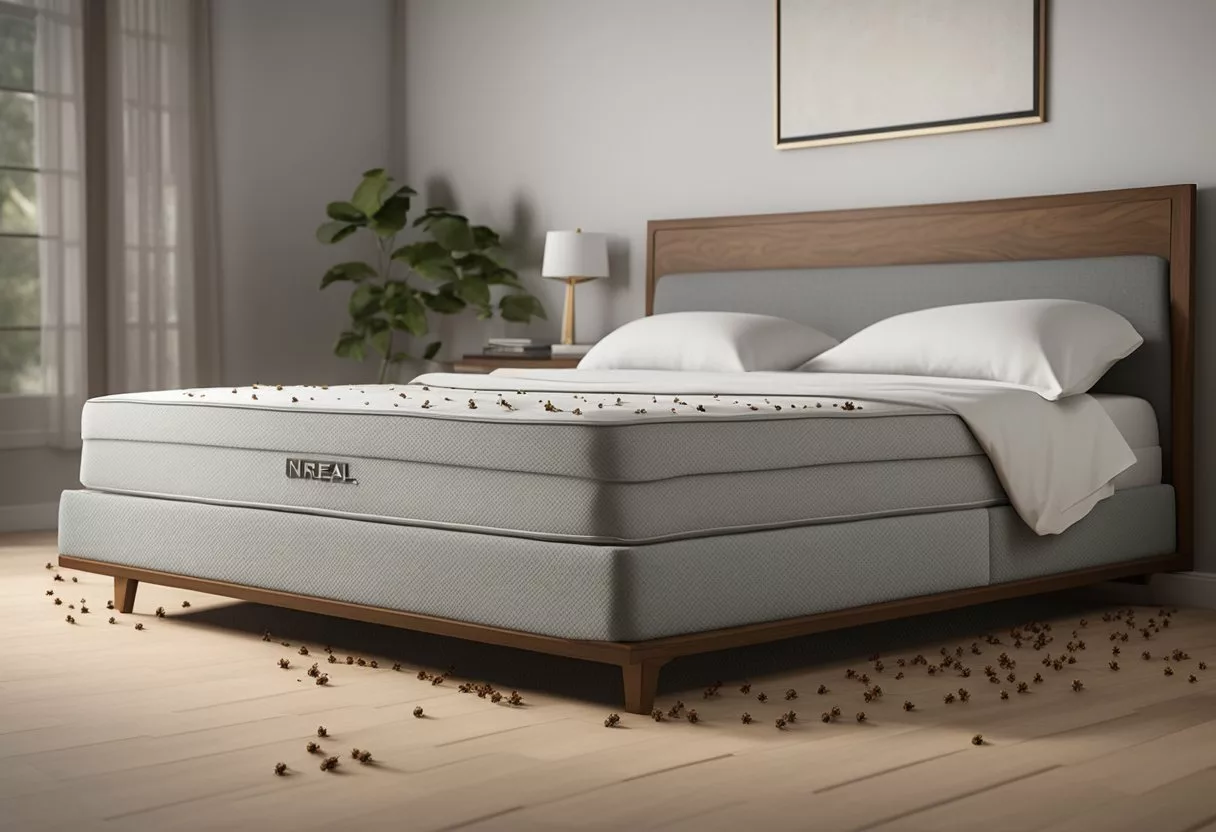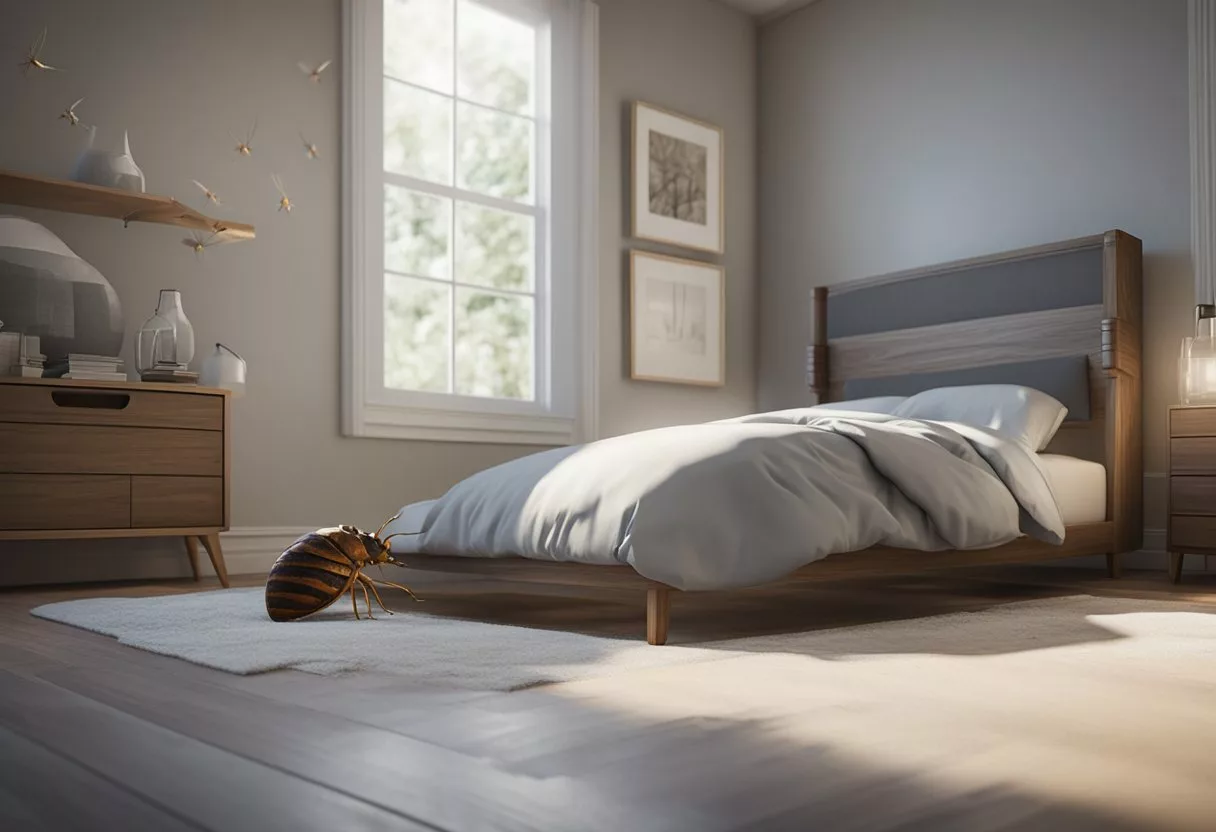Bed bugs are a common problem that can cause a great deal of discomfort and frustration for homeowners. These tiny insects feed on human blood and can quickly spread throughout a home if not dealt with promptly. Fortunately, there are several effective methods for getting rid of bed bugs.

Identifying a bed bug infestation is the first step in treating the problem. Bed bugs are small, reddish-brown insects that are about the size and shape of an apple seed. They are most commonly found in mattresses, box springs, and other areas where people sleep. Other signs of an infestation include tiny blood spots on sheets and a sweet, musty odor.
Preparation is key when it comes to treating bed bugs. This may include washing all bedding and clothing in hot water, vacuuming carpets and furniture, and sealing cracks and crevices where bed bugs may be hiding. Non-chemical treatments such as steam cleaning and freezing can also be effective, while chemical treatments should only be used by a professional exterminator.
Key Takeaways
- Identifying a bed bug infestation is the first step in treating the problem.
- Proper preparation is crucial for effective bed bug treatment.
- Non-chemical and chemical treatments should be used appropriately and by a professional if necessary.
Identifying Bed Bug Infestations

Bed bugs are small, reddish-brown insects that feed on the blood of humans and animals. Identifying a bed bug infestation can be tricky, as they are experts at hiding in small crevices and cracks. However, there are several signs that can indicate the presence of bed bugs.
Signs of Bed Bugs
One of the most common signs of bed bugs is the presence of small, rust-colored stains on bedding or furniture. These stains are caused by bed bugs being crushed while feeding on blood. Another sign of bed bugs is the presence of tiny, white eggs or eggshells, which can be found in the seams of mattresses or on furniture.
Bed Bug Bites and Symptoms
Bed bug bites are often the first sign of an infestation. The bites usually occur on exposed skin, such as the face, neck, arms, and hands. Bed bug bites can cause a range of symptoms, including itching, redness, and swelling. In some cases, a rash may develop.
Inspecting for Bed Bugs
To inspect for bed bugs, it is important to use a flashlight and a magnifying glass. Start by checking the seams and tags of the mattress, as well as the box spring. Bed bugs can also be found in cracks and crevices in the bed frame and headboard. Other areas to inspect include couch cushions, electrical outlets, and baseboards.
If a bed bug infestation is suspected, it is important to take action immediately. Bed bugs can reproduce quickly and can spread to other areas of the home. Professional extermination may be necessary to completely eliminate the infestation.
In summary, identifying a bed bug infestation requires a keen eye and attention to detail. Look for evidence of bed bugs, such as stains, eggs, or bites, and inspect common hiding spots with a flashlight and magnifying glass. If an infestation is suspected, contact a professional exterminator as soon as possible.
Preparation for Bed Bug Treatment

Before treating a bed bug infestation, it is important to prepare the space to ensure the treatment is effective. This involves reducing clutter, cleaning infested items, and isolating infested furniture.
Reducing Clutter
Reducing clutter in the infested area will help to minimize the number of places bed bugs can hide, making it easier to treat the infestation. Items that are not essential should be removed from the room and disposed of properly. Cluttered areas such as closets, dressers, and nightstands should be emptied and the contents should be placed in plastic bags to be treated or disposed of as needed.
Cleaning Infested Items
All infested items such as bedding, clothing, and curtains should be washed in hot water and dried on the highest heat setting for at least 30 minutes. This will kill any bed bugs and their eggs that may be present. Items that cannot be washed, such as shoes or stuffed animals, should be placed in a dryer on high heat for at least 30 minutes or placed in a plastic bag and stored for several months to ensure any bed bugs have died.
Isolating Infested Furniture
Infested furniture should be isolated from other furniture to prevent bed bugs from spreading to other areas of the home. Bed frames should be disassembled and the mattress and box spring should be encased in a special bed bug-proof cover. Furniture legs should be placed in plastic cups filled with talcum powder to prevent bed bugs from climbing up the legs.
Vacuuming the infested area before treatment can also help to reduce the number of bed bugs and their eggs. The vacuum bag should be removed and sealed in a plastic bag before being disposed of outside the home.
By following these preparation steps, treatment for a bed bug infestation will be more effective and efficient.
Non-Chemical Bed Bug Treatment Methods

Bed bugs can be a nightmare to deal with, but there are non-chemical treatment methods that can be effective. These methods include heat treatment, cold treatment, and steam treatment.
Heat Treatment
Heat treatment is one of the most effective non-chemical methods for getting rid of bed bugs. Bed bugs cannot survive in high heat, so exposing them to temperatures above 120°F (49°C) for a prolonged period of time can kill them.
One way to heat treat a room is to use a portable heater. The room should be heated to at least 120°F (49°C) and kept at that temperature for several hours. It is important to note that all areas of the room, including cracks and crevices, must be heated to ensure that all bed bugs are killed.
Cold Treatment
Cold treatment is another non-chemical method for getting rid of bed bugs. Bed bugs can be killed by exposing them to temperatures below 0°F (-18°C) for at least four days.
One way to cold treat items is to place them in a plastic bag and then put them in the freezer. It is important to note that the freezer must be set to 0°F (-18°C) or lower and that items must be left in the freezer for at least four days to ensure that all bed bugs are killed.
Steam Treatment
Steam treatment is a non-chemical method for getting rid of bed bugs that involves using a steamer to apply high heat to infested areas. The steam must be at least 130°F (54°C) to effectively kill bed bugs.
It is important to note that steam treatment can be effective, but it must be done correctly. The steamer should be used on all infested areas, including cracks and crevices. It is also important to use a diffuser to prevent bed bugs from scattering.
In addition to these non-chemical treatment methods, there are other things that can be done to prevent bed bugs from spreading, such as using mattress encasements and keeping a clean and clutter-free home.
Overall, non-chemical bed bug treatment methods can be effective, but they require careful and thorough implementation to ensure that all bed bugs are eradicated.
Chemical Treatments for Bed Bugs

Bed bugs are notoriously difficult to get rid of, and chemical treatments can be an effective way to eradicate them. However, it is important to select the right insecticides, take safety precautions, and apply the treatments correctly to ensure success.
Selecting the Right Insecticides
When selecting an insecticide, it is important to choose one that is specifically designed for bed bugs. Look for products that contain pyrethrins or pyrethroids, which are common compounds used to control bed bugs and other indoor pests. Pyrethrins are botanical insecticides derived from chrysanthemum flowers, while pyrethroids are synthetic chemical insecticides that act like pyrethrins. These compounds work by damaging the bed bug’s outer coating, causing them to dry out and die.
It is also important to choose an insecticide that is labeled for indoor use and is safe for use on bedding and furniture. Some common options include sprays, dusts, and aerosols. Be sure to read the label carefully and follow all instructions for use.
Safety Precautions with Chemicals
When using chemical treatments for bed bugs, it is important to take safety precautions to protect yourself and others. Wear gloves, long sleeves, and pants to avoid skin contact with the insecticide. Use a mask to avoid inhaling the chemicals, and ensure that the room is well-ventilated.
Keep children and pets away from the treated area until the insecticide has dried completely. Wash all bedding and clothing that may have come into contact with the insecticide before using them again.
Application of Chemical Treatments
Proper application of chemical treatments is crucial for success in eradicating bed bugs. Follow the instructions on the label carefully, and apply the insecticide to all areas where bed bugs may be hiding, including cracks and crevices, baseboards, and furniture.
It is important to apply the insecticide evenly and thoroughly, and to reapply as necessary. Some insecticides may require multiple applications to be effective.
In addition to insecticides, other chemical approaches to bed bug control include the use of rubbing alcohol and spray paint. Rubbing alcohol can be used to kill bed bugs on contact, but it is not effective for long-term control. Spray paint can be used to seal cracks and crevices where bed bugs may be hiding, but it is not a substitute for insecticides.
Overall, chemical treatments can be an effective way to get rid of bed bugs, but it is important to select the right insecticides, take safety precautions, and apply the treatments correctly to ensure success.
Professional Bed Bug Extermination

Bed bugs are notoriously difficult to eliminate, and some infestations may require professional intervention. In this section, we’ll cover when to hire a professional, how to choose a pest control service, and the benefits of integrated pest management.
When to Hire a Professional
Homeowners should consider hiring a professional exterminator if they have a large infestation, or if they have attempted to eliminate bed bugs on their own without success. A professional exterminator has access to specialized equipment and pesticides that are not available to the general public. They also have the expertise to develop a customized plan to eliminate bed bugs from your home.
Choosing a Pest Control Service
When choosing a pest control service, homeowners should look for a licensed and insured professional exterminator. They should also ask about the company’s success rate in eliminating bed bugs, and inquire about the types of products and methods used. It is important to choose a company that uses integrated pest management (IPM) techniques, which prioritize non-chemical methods of control before resorting to pesticides.
Integrated Pest Management
IPM is a holistic approach to pest control that emphasizes prevention, monitoring, and the use of non-chemical methods of control. This approach can be more effective and environmentally friendly than traditional pesticide-based methods. A professional exterminator who uses IPM will first conduct a thorough inspection of your home to identify the source of the infestation and determine the most effective course of action. They may use a combination of methods, such as vacuuming, steam treatment, and targeted pesticide application, to eliminate bed bugs from your home.
In some cases, legal action may be necessary to address a bed bug infestation. For example, if a tenant has a bed bug infestation in their apartment, they may be able to take legal action against their landlord to force them to address the problem. Homeowners should consult with a legal professional if they believe they have a case.
Overall, professional bed bug extermination can be an effective way to eliminate a bed bug infestation. By choosing a licensed and insured pest control service that uses IPM techniques, homeowners can ensure that their home is free of bed bugs and other pests.
Post-Treatment Considerations

After the bed bug treatment, it is essential to take some post-treatment considerations to ensure that the bed bugs are entirely eliminated and to prevent future infestations. Here are some things to keep in mind:
Monitoring for Bed Bugs After Treatment
It is crucial to monitor for bed bugs after treatment to ensure that the treatment was successful. The homeowner should continue to inspect their living space for any signs of bed bugs, such as live bugs, eggs, or fecal matter. If any evidence of bed bugs is found, the homeowner should contact the pest control company immediately to schedule a follow-up treatment.
Preventing Future Infestations
To prevent future infestations, the homeowner should take some precautions. When traveling, they should inspect their luggage and clothing for any signs of bed bugs before returning home. They should also wash all clothes in hot water and dry them on high heat to kill any potential bed bugs.
To prevent bed bugs from entering the home, the homeowner should seal any cracks or crevices in the walls, baseboards, and floors. They should also remove any clutter from their living space, as bed bugs can hide in clutter.
Legal Responsibilities and Rights
In some cases, the landlord or tenant may have legal responsibilities and rights regarding bed bug infestations. For example, the landlord may be responsible for paying for the bed bug treatment, while the tenant may be responsible for preparing the living space for treatment.
It is essential to understand the legal responsibilities and rights regarding bed bug infestations to ensure that the issue is resolved promptly and effectively.
In conclusion, taking post-treatment considerations is crucial to ensure that bed bugs are entirely eliminated and to prevent future infestations. Homeowners should continue to monitor their living space for any signs of bed bugs, take precautions when traveling, and understand their legal responsibilities and rights regarding bed bug infestations.
Special Considerations

Bed Bugs in Multi-Unit Buildings
If you live in an apartment or other multi-unit building, it’s important to notify your landlord or property manager immediately if you suspect a bed bug infestation. This can help prevent the infestation from spreading to other units and allow for prompt treatment.
It’s also a good idea to work with your neighbors to ensure that everyone is taking steps to prevent and control bed bugs. This may include regularly inspecting and cleaning your living space, sealing cracks and crevices, and properly disposing of infested items.
Bed Bugs and Travel
Bed bugs can easily hitch a ride in luggage and clothing, making travel a common way for bed bugs to spread. When staying in a hotel room, it’s important to inspect the room for signs of bed bugs before unpacking. This includes checking the seams of the mattress and box spring, as well as any upholstered furniture.
If you do find bed bugs in your hotel room, notify the front desk immediately and request a different room. When returning home from travel, inspect your luggage and clothing for any signs of bed bugs and wash all items in hot water and dry on high heat.
Bed Bugs and Pets
While bed bugs do not typically feed on pets, they can still hitch a ride on your furry friends. Regularly inspect your pets for signs of bites or bed bugs, particularly if they have been in an infested area. Wash your pet’s bedding and toys regularly and vacuum carpets and upholstery frequently to help prevent bed bugs from taking up residence in your home.
Remember, getting rid of bed bugs can be a difficult and time-consuming process. If you suspect a bed bug infestation, it’s important to act quickly and seek professional help if necessary.
Frequently Asked Questions

What methods can instantly kill bed bugs?
Unfortunately, there are no instant methods to kill bed bugs. Bed bugs are hardy insects that can survive extreme temperatures and even some chemicals. However, some methods like steam cleaning and vacuuming can kill bed bugs on contact.
What are the most effective home remedies for bed bug eradication?
Home remedies such as diatomaceous earth, tea tree oil, and lavender oil are often touted as effective bed bug remedies. However, there is limited scientific evidence to support their effectiveness. It is best to use a combination of professional treatment and preventive measures to eradicate bed bugs.
How can I eliminate bed bugs from a mattress using baking soda?
Baking soda is not an effective method to eliminate bed bugs from a mattress. While it may absorb odors and moisture, it will not kill bed bugs. It is best to use professional treatment methods such as heat treatment or chemical treatment to eradicate bed bugs from a mattress.
Is it possible to completely remove bed bugs in a single day?
It is unlikely to completely remove bed bugs in a single day. Bed bug treatment usually requires multiple visits from a professional exterminator and a combination of treatment methods. It is also important to follow preventive measures to prevent future infestations.
Which chemicals are proven to exterminate bed bugs and their eggs?
Chemicals such as pyrethroids, neonicotinoids, and insect growth regulators (IGRs) are proven to exterminate bed bugs and their eggs. However, it is important to use these chemicals safely and according to the manufacturer’s instructions. It is best to hire a professional exterminator to apply these chemicals.
Can bed bug infestations be effectively treated without professional help?
While DIY methods can be effective in preventing bed bug infestations, it is usually not effective in treating an existing infestation. Professional help is recommended to effectively treat bed bug infestations. Professional exterminators have access to specialized equipment and chemicals that are not available to the general public.